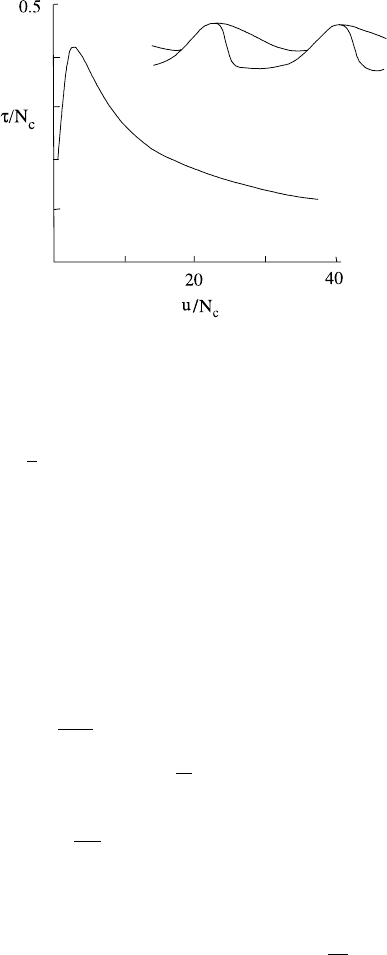Fowler A. Mathematical Geoscience
Подождите немного. Документ загружается.


660 10 Glaciers and Ice Sheets
Fig. 10.9 Stress versus
velocity for a bed of isolated
bumps. The inset shows the
typical form of the separated
flow on the decreasing
portion of the curve, when the
cavities reach the next bump
and indeed, such cavities are plentifully observed. An appropriate generalisation of
(10.211) is then
L
+
+L
−
=u
∗
h
in C
,
L
+
−L
−
=−
1
2
iN
c
in C,
(10.215)
where the bed is divided into cavities (C) where P is known (=−N
c
), and attached
regions where h is known. One can solve this problem to find the unknown cavity
shapes, and for a bed consisting of isolated bumps, τ
b
(u
b
) increases monotonically
for small u
b
, reaches a maximum, and then decreases for large u
b
,asshownin
Fig. 10.9. The decreasing portion of the curve is unstable (increasing velocity de-
creases drag) and is caused by the roofs of the cavities from one bump reaching the
next bump.
From (10.206) it follows that N
c
in (10.215) is proportional to the effective pres-
sure N =p
i
−p
w
, specifically
N
c
=
σN
ν[τ ]
, (10.216)
and in fact the sliding law has the specific form τ
b
=Nf (
u
b
N
). For a nonlinear Glen’s
law, the generalisation must take the form
τ
b
=Nf
u
b
N
n
. (10.217)
The reason for this is that one can scale the problem in the nonlinear case using
p − p
i
,τ
ij
∼ N, u ∼A[x]N
n
, x ∼[x], and the consequent sliding law must be of
the form (10.217) (assuming the regelative component is small). In particular, note
that the fraction s of uncavitated bed must be a decreasing function of Λ =
u
b
N
n
.
The multivaluedness of u
b
(τ
b
) is very suggestive of surging—but is it realistic?
Consideration of more realistic (non-periodic) beds suggests that the multivalued-
ness remains so long as the peak roughness amplitude is relatively constant. How-
ever, if there are increasing large bumps—pinning points, riegels—one might ex-
pect that f(·) in (10.217) will be an increasing function of its argument, since when

10.3 Sliding and Drainage 661
smaller bumps start to be drowned, larger ones will take up the slack. A plausible
sliding law then has f(ξ) increasing as a power of ξ, whence we can obtain (for
example)
τ
b
=cu
r
b
N
s
, (10.218)
where we would expect r, s > 0. More specifically, (10.217) would suggest s =1 −
rn, and also that r ≈
1
n
would be appropriate at low u
b
, where cavitation is absent.
When cavitation occurs, one would then expect lower stresses, so that r<
1
n
. There
is in fact some experimental and field evidence consistent with laws of this type,
with r ≈ s ≈
1
3
, for example. More detailed theoretical studies suggest that f(Λ)
will eventually reach a maximum which is determined by the largest wavelength
bumps.
An apparently altogether different situation occurs when ice slides over wet, de-
forming till. If the till is of thickness d
T
and has (effective) viscosity η
T
, then an
appropriate sliding law would be
τ
b
=
η
T
u
b
d
T
. (10.219)
In fact, till is likely to have a nonlinear rheology, and also in accordance with Terza-
ghi’s principle of soil mechanics, one would expect η
T
to depend on effective pres-
sure N . One possible rheology for till
14
gives the strain rate as
˙ε =A
T
τ
a
N
b
, (10.220)
in which case the sliding law would be again of the form (10.218), with c =
(A
T
d
T
)
−1/a
, r = 1/a, s = b/a. If the till is taken to be plastic, then we would
have r =0, s =1, corresponding to (10.220) when a =b 1. Thus there are some
good reasons to choose (10.218) as an all purpose sliding law, and this points up the
necessity of a subglacial hydraulic theory to determine N.
10.3.1 Röthlisberger Channels
Subglacial water is generated both by basal melt (of significance in ice sheets) and
from run-off of surface melt or rainfall through crevasses and moulins, which access
the glacier bed. Generally the basal water pressure p
w
is measured to be below
the overburden ice pressure p
i
, and the resulting positive effective pressure N =
p
i
− p
w
tends to cause any channels in the ice to close up (by creep of the ice).
In fact, water is often seen to emerge from outlet streams which flow through large
tunnels in the ice, and the theory which is thought to explain how such channels
14
The choice of a suitable till rheology is problematic, since till is a granular material, and therefore
has plastic behaviour, i.e., a yield stress. It is a matter of current interest whether any kind of viscous
rheology is actually appropriate. Further discussion is given in the notes.

662 10 Glaciers and Ice Sheets
remain open asserts that the channel closure rate is balanced by melt back of the
channel walls by frictional heating due to the water flow.
The classical theory of subglacial drainage is due to Röthlisberger, and is de-
scribed below. Much more detail, including the effects of time dependence in the
model, is provided in Chap. 11. Here we discuss only the determination of effective
pressure in steady state conditions. We consider a single channel of cross-sectional
area S, through which there is a water flux Q.WetakeQ as being determined by
external factors such as surface meltwater runoff; this is appropriate for glaciers,
but not for ice sheets, where Q must be determined by subglacial melting (we come
back to this later). If the flow is turbulent, then the Manning law for flow in a straight
conduit is
ρ
w
g sin α −
∂p
∂s
=
f
1
Q
2
S
8/3
, (10.221)
where ρ
w
is water density, g is gravity, s is distance down channel, α is the local bed
slope, and we write p =p
w
for water pressure; f
1
is a roughness coefficient related
to the Manning friction factor.
15
If we suppose that the frictional heat dissipated by
the turbulent flow is all used to melt the walls, then
mL =Q
ρ
w
g sin α −
∂p
∂s
, (10.222)
where L is the latent heat, and m is the mass of ice melted per unit length per unit
time.
The last equation to relate the four variables S, Q, p and m stems from a kine-
matic boundary condition for the ice, and represents a balance between the rate at
which the ice closes down the channel, and the rate at which melting opens it up:
m
ρ
i
=KS(p
i
−p)
n
; (10.223)
here m/ρ
i
is the rate of enlargement due to melt back, while the term on the right
hand side represents ice closure due to Glen’s flow law for ice; the parameter K is
proportional to the flow law parameter A.
Elimination of m and S yields a second order ordinary differential equation for
theeffectivepressureN =p
i
−p, which can be solved numerically. However, it is
also found that typically ∂p/∂s ρ
w
g sin α (in fact, we expect ∂p/∂s ∼ρ
w
gd/l,
so that in the notation of (10.11), the ratio of these terms is of O(μ)); the neglect
of the ∂p/∂s term in (10.221) and (10.222) is singular, and causes a boundary layer
15
Retracing our steps to (4.17), we see that f
1
= ρ
w
gn
2
G, where the geometrical factor G =
(
l
2
S
)
2/3
=6.57 for a full semi-circular channel; l is the wetted perimeter.

10.3 Sliding and Drainage 663
of size O(μ) to exist near the terminus in order that p decrease to atmospheric
pressure.
16
Away from the snout, then
S ≈
f
1
Q
2
ρ
w
g sin α
3/8
,KSN
n
≈
Qρ
w
g sin α
ρ
i
L
, (10.224)
thus
N ≈βQ
1/4n
, (10.225)
where
β =
ρ
w
g sin
11/8
α
ρ
i
LKG
3/8
n
3/4
1/n
(10.226)
is a material parameter which depends (inversely) on roughness. Taking ρ
w
=
10
3
kg m
−3
, ρ
i
= 917 kg m
−3
, g = 9.81 m s
−2
, L = 3.3 × 10
5
Jkg
−1
, K =
0.5 × 10
−24
Pa
−n
s
−1
, n = 3, sin α = 0.1, G = 6.57 and n
= 0.04 m
−1/3
s, we
find β ≈24.7 bar (m
3
s
−1
)
−1/12
, so that N ≈30 bars when Q =10 m
3
s
−1
. Since
p
i
=9 bars for a 100 metre deep glacier, it is clear that the computed N may exceed
p
i
. In this case, p must be atmospheric and there will be open channel flow. It is
likely that seasonal variations are important in adjusting the hydraulic régime.
Arterial Drainage
A feature of the Röthlisberger system is the surprising fact that as the water pressure
is increased (so N decreases), the water flux decreases. This is opposite to our com-
mon expectation. A consequence of this is that the channels, like Greta Garbo, want
to be alone; if one puts two channels of equal size and equal effective pressures side
by side, each carrying a water flux Q, then a perturbation Q > 0 in the flow of one
channel will cause an increase in N , and thus a decrease in water pressure, relative
to the other channel. Because the bed of a glacier will be leaky, this allows the now
smaller channel to drain towards the bigger one, and thus the smaller one will close
down. This process, the formation of larger wavelength pattern from smaller scales,
is known as coarsening, and occurs commonly in systems such as granular flows,
river system development and dendritic crystal growth, and is not fully understood,
although the apparent mechanism may be clear (as here).
A consequence of this coarsening is that we expect a channelised system to form
a branched, arborescent network, much like a subaerial river system. The difference
is that tributaries oblique to the ice flow will tend to be washed away by the ice flow,
so that only channels more or less parallel to the ice flow will be permanent features.
Presumably, tributary flow will thus be facilitated by the presence of bedrock steps
and cavities, which can shield the tributaries from the ice flow.
16
At least, this would be the boundary condition if the channel were full all the way to the margin.
In practice, this is not the case. Glacial streams typically emerge from a cavern which is much
larger than the stream, and in this case it is appropriate to specify that the channel pressure is
atmospheric where the ice pressure is positive. In any case, the Röthlisberger theory makes no
sense if p =p
i
, since then we would have m =0 and thus Q =0.

664 10 Glaciers and Ice Sheets
10.3.2 Linked Cavities
The channelised drainage system described above is not the only possibility. Since
water will also collect in cavities, it is possible for drainage to occur entirely
by means of the drainage between cavities. A simple way to characterise such a
drainage system is via a ‘shadowing function’ s which is the fraction of the bed
which is cavity-free. From our discussion following (10.217), s is a monotonically
decreasing function of
Λ =
u
N
n
, (10.227)
where u is the sliding velocity. If P is the normal ice stress over the cavity-free part
of the bed, then a force balance over the bed suggests that
p
i
=sP +(1 −s)p, (10.228)
where p is the water pressure in the cavities and p
i
= N + p is the far field ice
pressure. We imagine a system of cavities linked by Röthlisberger-type orifices.
17
If there are n
K
such cavities across the width of a glacier, then the total water flow
Q divides into
Q
n
K
per channel, subjected to a local effective pressure P −p =
N
s
.
Röthlisberger dynamics then dictates that the effective pressure is given by
N
s(Λ)
=δN
R
, (10.229)
where N
R
is given by (10.225), Λ by (10.227), and
δ =
1
n
K
1/4n
< 1. (10.230)
Linked cavity drainage thus operates at a higher pressure than a channelised
drainage system. This very simple description is at best qualitatively true, but it
is very powerful (and therefore tempting), as we shall see.
Stability
If there are two different styles of drainage, one may ask which will occur in prac-
tice? For the linked cavity system, the answer to this lies in the inverse to our discus-
sion of arterial drainage above. A linked cavity system is an example of a distributed
drainage system, and if we denote the corresponding effective pressure by N
K
(sat-
isfying (10.229)), then the system will be stable if N
K
(Q) < 0. In this case, any
local enlargement of an inter-cavity passage will relax stably back to the distributed
system.
It is convenient to define L(Λ) via
L =ln
1
s
; (10.231)
17
The cavities are the veins, and the orifices are the arteries, of the subglacial plumbing system.

10.3 Sliding and Drainage 665
L is a monotonically increasing function of Λ, and for illustrative purposes we will
take it, for the moment, as linear (this is inessential to the argument). Calculation of
N
K
(see Question 10.10) shows that
−
N
K
N
K
(nΛL
−1) =
N
R
N
R
, (10.232)
and thus the linked cavity system is stable if
Λ>Λ
c
=
1
nL
. (10.233)
If Λ<Λ
c
, then local perturbations will cause inter-cavity passages to grow, forming
channels which will eventually coarsen to result in a single central Röthlisberger
artery.
More generally, the effective pressure defined by (10.229) can be written in the
form
n
1/4n
K
N exp
L
u
N
n
=βQ
1/4n
, (10.234)
which yields a family of curves (depending on the number n
K
of channels) which
relate N to water flow Q: see Fig. 10.10. All of these curves have their turning
point at Λ = Λ
c
. To the left of these minima, Λ>Λ
c
and a distributed system
is preferred, with n
K
increasing (fine-graining) until limited by the cavity spacing.
To the right of the minima, coarsening will occur until a single channel (n
K
= 1)
occurs.
Fig. 10.10 Illustrative form of the drainage effective pressure given by (10.234) relating effective
pressure N to water flow Q through a field of linked cavities. The specific functions used in the
figure are L(Λ) =
1−e
−kΛ
k
, Λ =
u
N
n
,withk =0.2, u =1, n =3. For the curve labelled K (which
is the continuation of that labelled F) n
K
=200, while for the lower (R) curve n
K
=1. The three
components of the curve represent F: patchy film flow; K: linked cavities; R: Röthlisberger channel.
To the right of the minimum of the curve (here at N ≈ 1.41), Λ<Λ
c
, and the drainage channels
coarsen, leading to the single Röthlisberger channel R. To the left of the minimum, distributed
drainage is stable, and this takes the form of linked cavities K for N>0. However, if N →0, we
suppose that some of the bed remains in contact with ice, thus the shadowing function remains
positive, and this allows a film flow F as the water flux decreases to zero

666 10 Glaciers and Ice Sheets
A question arises, what happens at very low water fluxes, when (10.234) suggests
no corresponding value of N if L is linear. In reality, we expect that at very low
water fluxes, water will trickle along the bed in a patchy film, while the ice is in
effective contact with the larger clasts of the bed. If this is the case, then it indicates
that s, and thus also L, should saturate at large Λ. The effect of this is then to cause
Q given by (10.234) to reach a maximum at small N , and then decrease sharply to
zero. This gives us a third branch, which we associate with film flow, when there is
insufficient water flux to develop proper orifice flow between cavities.
In this view of the drainage system, there is really no difference between streams
and cavities, or between linked cavities and Röthlisberger channels and patchy films;
the only distinction is of one of degree. Intrinsic to our conceptual description is an
assumption of bimodality of bed asperity size. The small scale granularity of the
bed allows a trickling flow at small Q, while the larger bumps allow cavities and
inter-cavity orifices; but while this assumption is a useful imaginative convenience,
it is probably inessential.
10.3.3 Canals
A further possible type of drainage is that of a system of canals. This refers to sit-
uations where ice flows over a layer of subglacial sediments, which will commonly
take the form of till, with its bimodal mixture of fine particles and coarse clasts. If
the basal ice is temperate and there is subglacial water, then it is commonly thought
that the permeability will be sufficiently low that some sort of subglacial stream
system must develop.
18
If the till is very stiff, then this can take the form of Röth-
lisberger channels. On the other hand, if the till is erodible, then the channels may
become incised downwards into the sediments. It is this situation which we now try
and describe.
Because there are now two different wetted perimeters, both the ice and the till
dynamics must be considered. That for the ice is similar to the Röthlisberger chan-
nel, except that we do not assume that the channel is semi-circular. Rather, we iden-
tify a mean width w and a depth h. The semi-circular case is recovered if h ∼ w.
We take the cross-sectional area to be
S =wh. (10.235)
If we assume a Manning flow law in the canal, then (cf. (4.18))
τ =
ρ
w
gn
2
u
2
R
1/3
, (10.236)
18
This may not always be necessary; shear and consequent fracture of the till may allow higher
permeability pathways, and consequent drainage to bedrock, if there is a basal aquifer. However,
this scenario seems unlikely for a deep till layer which only deforms in its uppermost part.

10.3 Sliding and Drainage 667
where u is the mean velocity, and
R =
S
l
(10.237)
is the hydraulic radius, with l being the wetted perimeter; we take
l ≈2w, (10.238)
which will serve for both wide and semi-circular channels.
The rate of ice melting is
˙m
i
=
τuw
L
, (10.239)
while a force balance yields
τl ≈ρ
i
gSS
i
, (10.240)
where S
i
is the ice surface slope (this ignores the relatively small difference between
ice and water densities, and also the gradient of effective pressure). We suppose that
melting balances ice closure, so that
˙m
i
=ρ
i
Kw
2
N
n
, (10.241)
where K is a shape-dependent closure rate coefficient; (10.241) is appropriate for
both semi-circular and wide channels. Finally, the water flux is
Q =Su. (10.242)
Counting equations, we see that only one further equation is necessary to determine
N in terms of Q, and this involves a description of the sediment flow. Eliminating
subsidiary variables, we find
w
2
=
2
4/3
ρ
w
n
2
Q
2
ρ
i
S
i
h
10/3
,Kw
2
N
n
=
gS
i
Q
2L
, (10.243)
which can be compared with (10.224). In particular, if we take w ≈ h, then we
regain the Röthlisberger relation (10.225), with
β =
gS
i
2KL
ρ
i
S
i
2
4/3
ρ
w
n
2
3/8
1/n
, (10.244)
comparable to (10.226).
Now we consider the appropriate choice of depth for a canal. On the face of it,
there is little difference between the combined processes of thermal erosion (melt-
ing) and ice creep, and sediment erosion and till creep. But there is a difference, and
that lies in the rôle played by gravity. The shape of subaerial river channels is me-
diated by the fact that non-cohesive sediments cannot maintain a slope larger than
the angle of repose, and when subject to a shear stress, the maximum slope is much
less. Consequently, river beds tend to be relatively flat, and rivers are consequently
wide and shallow. Therefore, if subglacial till is erodible, as we expect, the resulting

668 10 Glaciers and Ice Sheets
channel will tend to have a depth which is not much greater than that which pro-
vides the critical stress for transporting sediment. As an approximation, we might
thus take
τ ≈τ
c
=μ
c
ρ
sw
gD
s
, (10.245)
where μ
c
≈0.05 is the critical Shields stress, and D
s
is a representative grain size,
probably of the small size particles. In this case, the depth of the canal is given by
h ≈h
c
=
2μ
c
ρ
sw
D
s
ρ
i
S
i
. (10.246)
Using values μ
c
=0.05, ρ
sw
=1.6×10
3
kg m
−3
, ρ
i
=0.917×10
3
kg m
−3
, D
s
10
−3
m, S
i
=10
−3
, we find h 20 cm.
If we assume that the channel depth is controlled by sediment erosion as in
(10.246), then the relations in (10.243)give
N =
γ
Q
1/n
, (10.247)
where
γ =
ρ
i
gS
2
i
h
10/3
c
2
7/3
KLρ
w
n
2
1/n
. (10.248)
Using similar values as before with h
c
=0.2 m, we find γ ≈0.32 bar (m
3
s
−1
)
1/3
.
There are two important consequences of (10.247). The first is that N decreases
with Q, so that, unlike Röthlisberger channels, canals as described here will form a
distributed system, just like the linked cavity system; in effect there is little differ-
ence other than a semantic one between the two systems. The second consequence
is that for any reasonable values of Q, say 0.1–10 m
3
s
−1
, the effective pressure is
much less than that of a channelled system, in a typical range 0.1–0.6 bars, similar
to that found on the Siple Coast ice streams. The inverse dependence of N on Q also
has an important dynamic effect on the ice flow, as we discuss below in Sect. 10.4.3.
An issue of concern in this description is that we have apparently ignored the
details of sediment creep and canal bank erosion, despite the apparent similarity
to the processes of ice creep and thermal erosion. We will have more to say on
this in Sect. 10.5.2, but for the moment we simply observe that in our theoretical
description, we have arbitrarily assumed that the ice surface is (relatively) flat. The
rough basis for this assumption lies in our expectation that it will be appropriate if
the till is much softer than the ice, but in order to quantify this, it is necessary to write
down a model which allows description of both the upper ice/water interface and the
lower water/sediment interface. The basis for such a model is given in Sect. 10.5.2,
when we (briefly) discuss the formation of eskers.
10.3.4 Ice Streams
A modification of the discussion of ice shelves occurs when we consider an appro-
priate model for ice streams. Ice streams, in particular those on the Siple Coast

10.3 Sliding and Drainage 669
of Antarctica, are characterised by small surface slopes and high velocities. On
ice streams such as the Whillans ice stream B, the depth d
i
∼ 10
3
m and the ice
surface slope is ∼10
−3
, so that the basal shear stress is ∼0.1 bar. If we suppose
that the effective viscosity η
i
=
1
2Aτ
n−1
≈ 6 bar y, and take the velocity scale as
U ∼500 m y
−1
, then the corresponding shear stress scale η
i
U/d
i
∼3 bar: evidently
motion is largely by sliding. We thus introduce a new dimensionless parameter λ,
which is the ratio of the magnitude of the actual basal stress to the shear stress scale:
λ =
τ
0
d
i
η
i
U
, (10.249)
where τ
0
=ρ
i
gd
i
ε is the basal stress scale, ε being the aspect ratio. Using the values
quoted above, we may estimate λ ∼0.03.
We follow the exposition in Sect. 10.2.2 (and its three-dimensional modifi-
cation in Question 10.4), with the distinction that the shear stresses are scaled
as τ
13
,τ
23
∼ τ
0
, while the longitudinal stresses are scaled as p − p
a
− ρ
i
g(s −
z), τ
12
,τ
11
,τ
22
,τ
33
∼
η
i
U
l
; then the scaled model (10.38) takes the form
u
x
+v
y
+w
z
=0,
τ
13,z
=s
x
+
ε
2
λ
[p
x
−τ
11,x
−τ
12,y
],
τ
23,z
=s
y
+
ε
2
λ
[p
y
−τ
12,x
−τ
22,y
],
p
z
−τ
33,z
=λ(τ
13,x
+τ
23,y
),
u
z
+ε
2
w
x
=λAτ
n−1
τ
13
,
v
z
+ε
2
w
y
=λAτ
n−1
τ
23
,
u
y
+v
x
=Aτ
n−1
τ
12
,
2u
x
=Aτ
n−1
τ
11
,
2v
y
=Aτ
n−1
τ
22
,
2w
z
=Aτ
n−1
τ
33
,
τ
2
=τ
2
13
+τ
2
23
+
ε
2
λ
2
1
2
τ
2
11
+
1
2
τ
2
22
+
1
2
τ
2
33
+τ
2
12
.
(10.250)
This allows for a temperature-dependent rate factor A, but we will now suppose
A =1. The boundary conditions are, on z =s:
τ
13
=
ε
2
λ
(−p +τ
11
)s
x
+τ
12
s
y
,
τ
23
=
ε
2
λ
τ
12
s
x
+(−p +τ
22
)s
y
,
p −τ
33
=λ(−τ
13
s
x
−τ
23
s
y
),
w =s
t
+us
x
+vs
y
−a,
(10.251)
while at the base z =b(x,y,t):
(u, v) =u
b
,w=ub
x
+vb
y
. (10.252)
